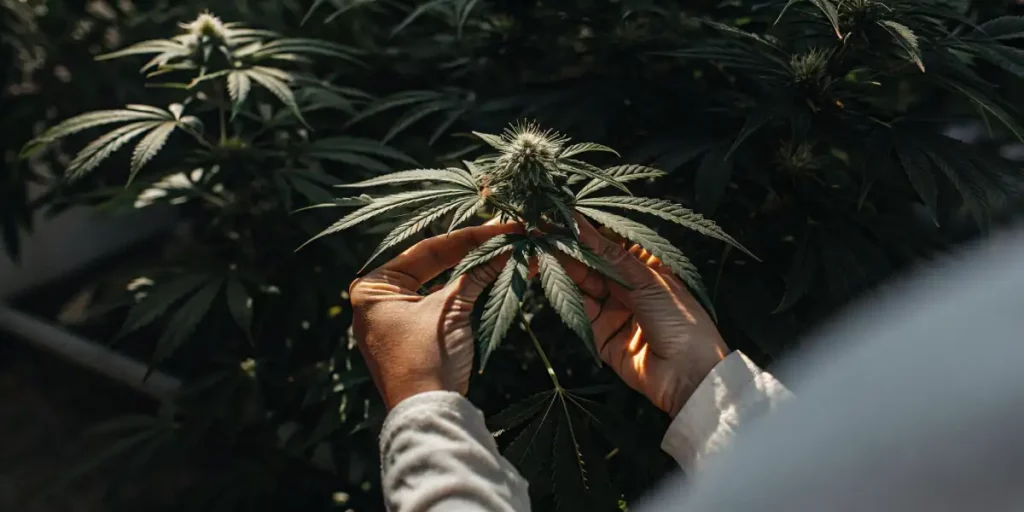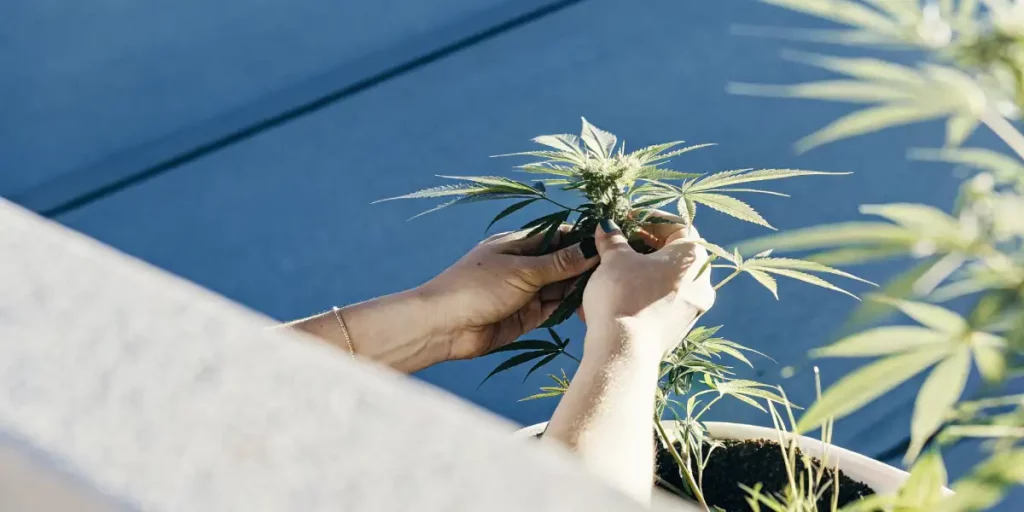Topping autoflowers can be a game-changer for many growers. This simple technique helps manage the plant’s height and potentially increase yield. It’s a practice that involves cutting the plant’s main stem to encourage two main colas instead of one. While it sounds straightforward, topping requires timing and skill to avoid stunting growth.
Autoflowering cannabis strains have their own growth cycle, independent of light schedules. This makes topping them a bit different from photoperiod strains. Autoflowers switch from vegetative growth to flowering on their own, usually within 2-4 weeks. Therefore, knowing the best time to top autoflower plants is crucial to avoid disrupting their natural rhythm.
When you decide to top autoflowers, timing is everything. Most growers recommend doing so once the plant has developed 3-4 nodes. Nodes are the points on the plant where leaves and branches grow. Topping too early can stunt growth, while topping too late can impact the plant’s energy distribution.
Techniques for Topping Autoflower Cannabis
There are several techniques for topping autoflower cannabis. Each method aims to achieve the same result: a bushier plant with more colas. The simplest method involves using clean scissors or a sharp blade to cut the main stem just above a node.
Another approach is to use your fingers to pinch off the new growth at the top. This technique is sometimes preferred because it causes less shock to the plant. No matter which method you choose, ensure your tools are sterile to prevent infection.
Experimenting with different techniques for topping autoflower cannabis can also help you determine what works best for your specific setup. Some growers find that using a combination of methods provides the best results, allowing them to fine-tune their approach based on the strain and growing environment.
It’s important to remember that every plant is unique, and what works for one strain may not be suitable for another. Observing your plants and adjusting your methods accordingly can lead to more successful outcomes. Taking the time to understand the nuances of topping autoflowers will improve your overall growing skills.
Pros and Cons of Topping Autoflowers
One of the main advantages of topping autoflowers is the potential increase in yield. By redirecting the plant’s energy to multiple colas, you can achieve a more even canopy and better light distribution. This can be especially beneficial for indoor growers with limited vertical space.
However, there are also downsides to consider. Topping can stress the plant, which may slow growth temporarily. This is particularly true if done incorrectly or too late in the plant’s life cycle. Some growers find that the impact of topping on autoflower yield isn’t significant enough to justify the stress it causes.
It’s essential to weigh the pros and cons of plant training techniques before deciding to implement them in your garden. While the potential for increased yield is appealing, the risk of stressing the plant must be carefully managed. Knowing these trade-offs can help you make an informed decision about whether training is right for you.
For those new to growing, experimenting with different pruning methods can provide valuable insights into plant care. By observing how your plants respond, you can refine your skills and develop a deeper knowing of their growth patterns and needs.

Best Time to Top Autoflower Plants
The best time to top autoflower plants typically falls between the plant’s third and fourth week. By this stage, the plant should have several nodes and be robust enough to handle the stress of topping. Waiting too long can mean missing the window for effective topping.
Observing your plants closely is key. Look for signs of vigorous growth and ensure the plant has at least 3-4 nodes. If you’re unsure, it’s better to err on the side of caution and skip topping rather than risk stunting your plant’s growth.
Timing is crucial when it comes to topping autoflowers, as it can greatly impact the plant’s overall health and yield. By knowing the best time to top autoflower plants, you can maximize the benefits of this technique and ensure your plants thrive.
Besides to timing, consider the specific characteristics of the strain you’re growing. Some strains may respond better to topping at different stages, so it’s important to research and understand your chosen variety. This knowledge will enable you to make informed decisions about when to top your plants.
Real-Life Examples of Topping Autoflowers
One grower shared their experience with topping the classic White Widow Auto from Global Green Genetics. They found that topping at the fourth node produced two strong main colas and increased their total yield. Another grower used the same technique on Blueberry Auto and noticed a significant difference in the plant’s bushiness.
These real-life examples highlight how topping can vary from strain to strain. Each autoflower has its unique characteristics. Strains like Gorilla Glue #4 Auto are also popular among those who practice topping due to their robust nature and ability to bounce back from stress.
By sharing and learning from real-life examples of topping, growers can gain valuable insights into how different strains respond to this technique. This collective knowledge can help you make more informed decisions about which strains to top and how to approach the process.
As you gain experience, keeping a detailed grow journal can be an invaluable tool. Documenting your methods, observations, and results allows you to track your progress and refine your technique over time. This practice not only benefits your current grow but also provides a valuable reference for future endeavors.
Impact of Topping on Autoflower Yield
The impact of topping on autoflower yield can be significant when done correctly. By creating more colas, the plant can potentially produce more buds. This is especially beneficial in smaller grow spaces where maximizing output is essential.
However, topping is not a guarantee of higher yields. Several factors, such as genetics, growing conditions, and the plant’s health, play a role in the final outcome. Ensuring your plant is healthy and well-nourished before topping increases the likelihood of a positive result.
The impact of topping on autoflower yield is influenced by various factors, including the strain’s genetics and the growing environment. Knowing these elements can help you optimize your growing conditions and achieve the best possible results from topping.
Besides to yield, topping can also affect the overall structure and appearance of the plant. By promoting a bushier growth pattern, topping can create a more aesthetically pleasing and manageable plant, which is especially beneficial in indoor growing setups.
Topping Autoflowers Plants for Beginners
For beginners, it’s important to start slow and be patient. Topping is a skill that improves with experience, so don’t be discouraged if your first attempt isn’t perfect. Choose easy-to-grow strains like Northern Lights Auto to build confidence.
Before starting, gather all necessary tools and ensure they are clean. Plan where you’ll make the cut and observe the plant’s growth pattern. This preparation helps minimize stress on the plant.
Topping autoflower plants for beginners can be an exciting and educational experience. With practice, you can develop the skills needed to confidently implement this technique in your garden, enhancing your overall growing expertise.
As you gain confidence, consider experimenting with different strains and techniques to discover what works best for you. By remaining open to learning and adapting, you can continually improve your abilities and achieve greater success in your growing endeavors.

FAQs of topping autoflowers
What is the best strain for topping autoflowers?
Choosing the right strain is crucial for successful topping. Northern Lights Auto is often recommended for its resilience and forgiving nature. This strain is less likely to suffer from stress, making it ideal for beginners.
Another excellent choice is Gorilla Glue #4 Auto, known for its robustness and ability to recover quickly from topping. Blueberry Auto is also popular among growers looking for flavorful yields and a plant that responds well to training techniques.
When selecting the best strain for topping autoflowers, consider the specific goals you have for your grow. Different strains may offer unique advantages, such as increased yield or faster recovery times, which can influence your decision.
Exploring various strains and observing their responses to topping can provide valuable insights into their growth characteristics. This knowledge allows you to make more informed choices and tailor your approach to suit your individual growing conditions and preferences.
Can topping autoflowers increase yield?
Topping autoflowers can increase yield by encouraging the growth of multiple colas. This allows for more buds and better light penetration. However, the overall yield also depends on other factors, such as plant health and growing conditions.
Not all strains respond the same way to topping, so it’s essential to experiment and observe your plants. Keeping a grow journal helps track your progress and refine your technique over time.
While topping has the potential to increase yield, achieving optimal results requires careful planning and attention to detail. By focusing on plant health and maintaining ideal growing conditions, you can maximize the benefits of topping and enhance your overall yield.
Regularly assessing your plants and making adjustments as needed will help ensure their success. As you gain experience, you’ll develop a deeper knowing of how topping affects your plants and be better equipped to make informed decisions about your growing strategies.
When is the best time to top autoflower plants?
The ideal time to top autoflower plants is between the third and fourth week of growth. By this stage, the plant should have enough nodes and be strong enough to handle the stress of topping.
Pay attention to your plant’s growth and choose the right moment carefully. Topping too early or too late can impact the plant’s development and yield potential.
Knowing the best time to top autoflower plants is crucial for achieving the desired results. By observing your plants closely and responding to their growth cues, you can optimize your topping strategy and enhance your overall success.
Besides to timing, consider factors such as the plant’s overall health and environmental conditions. These elements play a significant role in the success of your topping efforts and should be carefully monitored and adjusted as needed.
What are the pros and cons of topping autoflowers?
Pros of topping autoflowers include the potential for increased yield and a bushier plant structure. This can be especially beneficial in indoor setups with limited vertical space.
Cons include the risk of stunting growth if done incorrectly. Topping can stress the plant, temporarily slowing down its development. Weigh these factors carefully before deciding to top your plants.
By carefully considering the pros and cons of topping autoflowers, you can make an informed decision about whether this technique is suitable for your growing situation. Knowing the potential benefits and drawbacks will help you determine the best approach for your plants.
For many growers, the potential advantages of topping outweigh the risks, making it a valuable tool in their cultivation arsenal. As you gain experience and confidence, you’ll become more adept at managing the challenges associated with topping and maximizing its benefits.
Is topping autoflower plants suitable for beginners?
Topping autoflower plants can be suitable for beginners, especially with resilient strains like Northern Lights Auto. Starting with easy-to-grow varieties helps build confidence and refine your technique.
Beginners should focus on timing and preparation to minimize stress. With practice and patience, topping can become a valuable tool in enhancing your grow experience.
For those new to growing, topping autoflower plants can be an excellent way to learn about plant training and care. By starting with beginner-friendly strains, you can build a solid foundation of skills and knowledge that will serve you well in future grows.
As you develop your skills, consider seeking advice and insights from more experienced growers. This collaborative approach can provide valuable guidance and support, helping you navigate the challenges of topping and achieve greater success in your growing endeavors.

